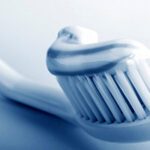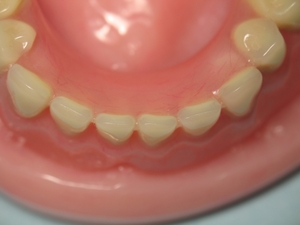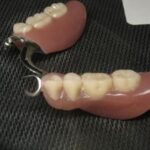If left on the plaque develops into tartar. To remove tartar your dental hygienist has to chip and scrape the hard white substance off. Tartar and plaque are responsible for gum disease and for dental decay causing serious root damage and possible loss of teeth.
Plaque is actually oral bacteria. We all have it but without proper oral care you will end up with gum disease and tooth decay. It is almost invisible but it will accumulate on teeth, fillings, crowns and even dentures. Tartar is a white, chalky substance that is a form of plaque and bacteria debris. Tartar enables plaque to stick better to the teeth but it is less harmful than plaque.
As plaque forms and remains on your teeth it goes through a chemical change and becomes more dangerous. Bacteria in the plaque feeds off of the foods we eat. In the process they produce an acid that literally eats away the tooth enamel. This leads to cavities. Other bacteria in the plaque can attack the gums and cause inflammation and bleeding. This is the first stage of gingivitis. If left untreated the gum disease will advance and you may loose your teeth.
You can remove most of the plaque and tartar with proper oral care but you should set up a cleaning schedule with your hygienist to professionally remove the plaque and tartar you can’t remove. Regular professional dental care and cleaning will make your own home care more effective. Regular dental checkups can help you check the progress of gum disease before it progresses too far.
The best thing that you can do to control tartar and plaque is to brush your teeth. If you brush incorrectly ten times a day you won’t get the benefits of one or two correct brushings. When we brush most of us worry about getting between our teeth and we completely miss the gum line. This is where most of the plaque and tartar goes. Hold your brush at a 45-degree angle against the gum line. When you are cleaning the upper teeth, point the brush upward toward the nose; for the lower teeth point the brush downward toward your chin.
Using the right brushing technique is very important. Use a short, back-to-forth motion to clean the outer surfaces of your teeth. Focus only on two teeth at a time. Don’t be forceful. You are not scrubbing grout. Using too much pressure can result in gum injuries, enamel abrasions and sensitive teeth. Use the same stroke on the inner surfaces keeping the brush angles at a 45-degree angle toward the gum line.
Gently scrub the chewing surfaces of your back teeth with the same back-and-forth motion keeping the brush flat.
For the front teeth use an up-and-down motion. Don’t forget to brush the back sides of your front teeth. Tilt the brush vertically and use the front part of the brush in short up-and-down strokes to clean the inside surfaces. Brush your tongue and the roof of your mouth. The tongue can harbor disease-causing bacteria.
Don’t use a hard bristle toothbrush. Hard bristles can actually wear away the enamel that protects your teeth and can cause grooves in your teeth where bacteria can multiply. Your tooth enamel may be hard but it is delicate. Using brush bristles that are too hard or brushing with too much force can also damage your gums causing them to recede or pull away from the teeth.
Choose a soft-bristled toothbrush. Buy a brush that is small enough to reach all the teeth even the ones way back in your mouth. You might want to use a toothbrush marketed for children. Replace your toothbrush often, too. About every three months is good. Do not wait until the bristles become worn or frayed.
Choose a flouride toothpaste to help strengthen your teeth and help prevent cavities. Don’t think that as you get older you don’t need fluoride or that you don’t need to protect your teeth from cavities. As you age your gums recede exposing tooth enamel coating and are more prone to a type of dental decay called root caries. Not only do you need flouride but your toothpaste should also provide tartar control.
You have to floss daily. Flossing is the only way to clean plaque and food debris from between the teeth and under the gums. Use plenty of floss. Wrap at least most of 24 inches of floss around the middle or index finger of one hand. Wrap the remaining floss around the same finger on the opposite hand. Use this finger as the take-up spool for the used floss. Using a clean piece of floss for each tooth is important. If you don’t you are re-introducing bacteria to another tooth.
Make sure you hold the floss taut. Hold the floss tightly with your thumbs and forefingers leaving about an inch of floss between your two hands. Use a sawing action. Pull the floss between the teeth using a gentle “sawing” action. Don’t snap the floss into your tender gums.
At the gumline gently curve the floss fitting it sungly around the tooth and slide it into the space between the gum and the tooth. Do not “dig” into the gum. Bring the floss out from under the gum and scrape the side of the tooth to remove the plaque. After you pull out the floss use a clean section of floss to clean the tooth on the other side. Don’t forget about the back side of the last tooth on each side.
If you have trouble using floss you can also try using floss treaders or floss holders to help you. Ask your dentist what they recommend for daily use.
Flossing and brushing are best done in a routine manner, the same way every time. Start at the same spot in your mouth each time and work your way around. Using the same routine will help keep you from missing spots as you brush and floss.
If you suffer from dry mouth you have an increase chance of bacteria taking control of your teeth and gums. Saliva keeps the mouth clean and helps fight bacteria. Take frequent sips of water or purchase products that help with dry mouth. Consult with your dentist for recommended products.
Diet is also important. Limit how often you eat sugary foods. Stick with a dessert only at meals. Don’t snack on hard candy or sip sweet drinks all day. Chew gum but make sure it is sugarless. Gum will stimulate the flow of saliva, cleanse your mouth and protect your teeth.
As soon as you notice a problem occuring with your teeth or gums you need to see your dentist.
Dental Guide To A Healthy Mouth




